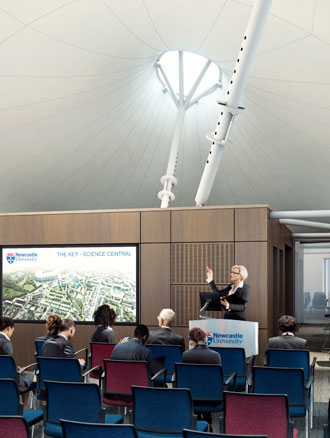July
Ideas bubble over at Science Central

Work has begun on a revolutionary ‘soap bubble’ building that will house the first research labs on Science Central.
Using similar technology to that developed by the Newcastle University team for the 2012 Olympic Stadium, the elegant lightweight fabric structure – called The Key – is being built on the same principles as a soap bubble.
“Given a set of fixed points, a soap film will spread naturally between them to offer the smallest achievable surface area,” explains Peter Gosling, Professor of Computational and Structural Mechanics at Newcastle University and leading the project.
“It follows similar principles to the giant bubbles children make where they pull the soap to create these huge cylindrical shapes.
“But more than that, the shape is also incredibly strong, so the resulting design is not only extremely efficient in terms minimising the materials it uses but also very resilient.
“What is really unique about The Key is that it will be the first time a fabric structure has been used as a working space and this presents a number of technical challenges for us around heating, lighting and insulation. So the structure itself will be as important as the research that is going on inside it.”
Being designed by experts at Newcastle University in conjunction with Arup and -space Architects, this will be the University’s first building on the city’s new urban innovation hub.
Aligned with the overall vision for the site to become an exemplar of sustainability, the fabric and timber structure has been designed to have minimum impact on the environment. Based on the iconic ‘Institute for Lightweight Structures’ building in Stuttgart, the roof canopy will be supported by a tri-star mast soaring 10m into the sky to maximise the natural light levels and reduce energy use through passive ventilation.
Providing a unique venue for research – where not just the inside of the building but the structure itself is used for teaching and learning – it will also be used to showcase the Science Central vision to business and industry leaders, policy-makers and local communities.
Led by Professor Peter Gosling and Dr Ben Bridgens of the School of Civil Engineering and Geosciences at Newcastle University, work on the building will begin in July and the aim is to have the building open and ready for business by the end of the year.
“This is a great opportunity to create a really exciting space that not only facilitates research and collaboration but also informs it,” says Dr Bridgens.
“The fabric, similar to that used for the roof of the 2012 Olympic Stadium, acts as both cladding and support while being extremely lightweight. This means that we can keep materials with a high carbon footprint, such as steel and concrete, to an absolute minimum.
“Inside, the open plan space and proposed lighting means we can create a day-through-night venue that is inspiring and engaging and like nothing else we have here in the North East.”
Andrew Grounsell, Associate Director at Space Architecture said: “This has been a collaborative project from the outset, seeing us work closely with both Newcastle University and the Arup-led design team to understand and deliver to their project needs and requirements.
“By its very nature The Key is an incredibly innovative and unique project that will itself be a research tool to examine tensile fabric performance and demountability for relocation to another site.
“The end result will be a fantastic spectacle, creating an iconic facility that can be relocated to another site in years to come.”
Gordon Mungall, Associate Director in Arup’s Newcastle office, added: "Developing the design of this project has been a real team effort. Our team in the Newcastle office has worked closely with our design partners, Space Architecture and Summers Inman, and the wider Newcastle University, to develop the innovative solution.
"The visually spectacular unique geometry, will provide an inspiring environment for the users and future researchers at the University."
Sunderland-based Brims Construction has been appointed building contractors for The Key. Brims Director Richard Wood said: “This an impressive development, which presents its own unique construction challenges.
“Having now been appointed as main contractor we hope we can add our expertise to the talents of the team who have been involved in the planning and design to date. We are delighted to play a part in helping the University bring this to fruition.”
Science Central is Newcastle’s £250 million flagship project bringing together academia, the public sector, communities, business and industry to create a global centre for urban innovation in the heart of the city.
Originally the Elswick Colliery, then later the production centre for Newcastle Brown Ale, the 24-acre site has been Newcastle’s industrial heart for 200 years.
Now the site is being transformed into an exemplar of urban sustainability, a ‘living laboratory’ where innovative urban technologies will be trialled.
Led by Newcastle University and Newcastle City Council through the Science City partnership, the development will include the University’s £58m Urban Sciences Building which will house the School of Computing Science, as well as an urban observatory and decision theatre, allowing real time data from the city to be analysed and explored so we can improve our understanding of the interaction between our city’s energy, water, transport, waste and digital control systems.
Professor Phil Taylor, Director of the Newcastle University Institute for Sustainability, adds: “Science Central is effectively a blank canvas and an opportunity to create something truly visionary.
“The ultimate goal is to provide a unique environment where internationally renowned engineers and scientists can work together with policy makers, industry, and communities to test emerging technologies and find solutions to global urban sustainability challenges.
“This innovative new building is a first step towards this final goal and makes a real statement about what we are trying to achieve on Science Central.”
published on: 14 July 2015
